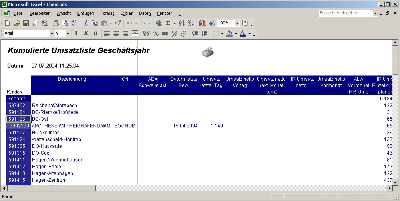Profile abstract
| Personal Information | ||
| Name | Thomas Schnauffer | |
| Address | North Bondi NSW, Australia | |
| Nationality | German | |
| Education | ||
| University of ULM, Studies in Business Mathematics Master of Mathematics and Economics |
||
| Languages | ||
| English | fluent | |
| French | average (5-year of school, one project in french speaking country) | |
| Japanese | little knowledge | |
| Hobbies | ||
| Music, Design (Furniture, Architecture), Travel, Reading, Computer Systems, Motor cycles | ||
Project Abstracts
OLAP Reporting
Web Based Reporting Application/Excel Based Reporting Application
The example is a combination of 2 solutions developed for 2 clients.
The core is a meta data database in Microsoft SQL Server which stores queries against both OLAP and relational databases. The applications are a web site on one hand and a full client with integration into Microsoft Excel on the other, which combines the queries to reports and provides lightweight reporting for OLE DB (OLAP and relational) databases.
Since I had be working both with MDX as the OLAP query language and reporting solutions based on OLAP databases, I had already an idea of creating a lightweight client application using a relational database as a meta data storage and a web server based application for creating HTML reports.

The report engine itself is based on three core tables for the report definition. The main section contains general information about the report like title, visibility in the menu structure etc. Other sections contain information about data area, selections and navigation.
Variables within the queries allow to configure the queries based on the selections.

The following screen show the resulting report.
Drill downs are available and selections can be stored in a "favourite" section.
The rich client then in use provided a much more flexible report design and functionality, with limitations to the clients' grids' row capabilities.
The following two screens show another sample report with the selection section in a VB form.
The rich client is implemented as DLL plugins for Microsoft Excel.

A separate administration application for the report design and the system management was also developed in VB as well.
Standalone ETL and Reporting Application
This project was originally proposed by the customers' external SAP development team as standard Excel VBA programming for integration into the SAP Sales application. Text files with report data from SAP Business Warehouse are stored in the sales managers local Microsoft SQL Server installation. These files contained the raw data for reporting.
The concept includes the following components:
- creation of the SAP reports in a table format for further processing containing all relevant information required for the reporting on the data
- extraction of the data in the text files from the Microsoft SQL Server blobs
- process the extracted data into OLAP Cubes
- generate reports from the OLAP Cubes
The next charts clarify the integration of the components.
The SAP solution is defined by a client application using a local database. The content is replicated.

Next and overview of the integration of the software developed.

This reporting solution is based on the following technology:
- Application DLLs for integration into Microsoft Excel which also was to be the user front end
- 2 XML files, one for processing configuration and one for the reports
- Microsoft OLAP offline cubes which are part of the Microsoft Excel functionality and there contained in the Microsoft Pivot Table component (Active X Data Object for OLAP).
- Reports based on MDX technology within Microsoft Excel
The first screen one shows 2 data areas (for a given customer a header section and a data section).
The second report shows the expansion of one data area using the build in drill down functionality for the dimension structure.
The last report shows a selection element with a double click on the dimension browser.
Profile







